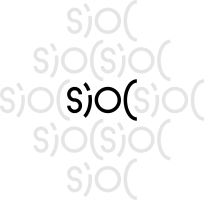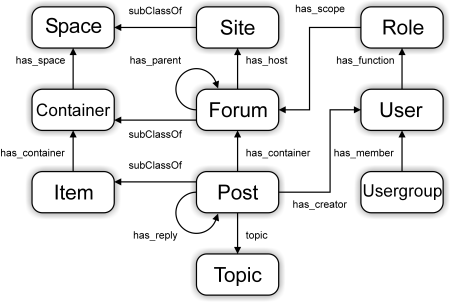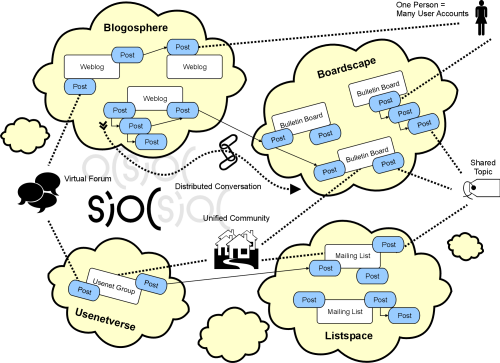SIOC/One Pager on SIOC for Sindice

What is SIOC?
SIOC (Semantically-Interlinked Online Communities) is an open schema for representing users, forums, posts and threads, containers, and other items in online community sites - for the purposes of data reuse, linking, portability and interoperability.
The aims of SIOC are:
- To fully describe the structure of content in community sites.
- To create new connections between forums and posts from different types of discussion systems (blogs, forums, mailing lists, etc.) and content items / containers on Web 2.0 sites.
- To browse connected posts and channels in interesting ways (e.g. distributed linked conversations, decentralised discussion channels and communities, etc.
As an open data format, SIOC can augment or replace proprietary data formats for knowledge exchange in social and collaborative software systems.
It can be combined with FOAF (Friend-of-a-Friend), SKOS (Simple Knowledge Organisation System) and other Semantic Web vocabularies to fully describe the networks of people, content items and topics that are being formed in online community sites.
SIOC terms
The SIOC schema defines the main concepts and properties required to describe information from online communities on the Semantic Web. The concepts used to describe discussion forums such as blogs and forums are Site, Forum and Post. Users create Posts organised in Forums which are hosted on Sites. These concepts are subclasses of a higher level concepts - data spaces (sioc:Space), containers (sioc:Container) and content items (sioc:Item) - which were added to SIOC as it evolved. These classes allow us to structure the information in online community sites and to distinguish between different kinds of objects. Properties defined in SIOC allow to describe relations between objects and attributes of these objects. The main terms in the schema are shown in the figure below.
Interlinking online communities with semantics
SIOC provides a unified vocabulary for content and interaction description: a semantic layer that can co-exist with existing discussion platforms. Using SIOC, various linkages are created between the aforementioned concepts, which allow new methods of accessing this linked data - including virtual forums, distributed conversations, unified communities, shared topics, and connecting people to their multiple user accounts - as shown below.
Some recent SIOC applications
SIOC is currently being used by companies in a variety of application domains. For example, OpenLink's Data Spaces product provide access to SIOC instance data (“think open social graph++") from a range of applications including blogs, wikis, aggregated feeds, shared bookmarks, discussions, photo galleries, briefcases (e.g. WebDAV file servers), etc. Engage is a community information application from Talis that combines SIOC in its schematics with SKOS for knowledge organization and FOAF for person description. The Seesmic "video microblogging" service has also adopted the SIOC ontology as one of their open platform formats. Talk Digger, a web service from Zitgist LLC that helps people to find, follow and enter conversations on the Web, exports all of their data using SIOC. And ImageMatters LLC have recently announced a new open-source social bookmarking and mash-up application called gnizr, that exports saved bookmarks using SIOC in combination with a tag ontology.
There are also many other open-source applications of SIOC coming from the web developer community. OpenQabal, an open source social networking and collaboration platform is supporting SIOC, allowing Roller, JavaBB and other component applications to become part of the SIOC-o-sphere. SIOC descriptions of fora are also being used for teaching and learning, for example, in the Fishtank project for Faculty Academy which leverages the structure and searching power of RDF. IkeWiki, a wiki for knowledge engineering, allows discussions represented using the SIOC ontology (following a forum style with threaded views) to be attached to wiki pages. SWAML, the Semantic Web Archive of Mailing Lists, uses SIOC as its base ontology. The project also includes Buxon, a sioc:Forum visor written in PyGTK. Finally, a third-party RDF exporter for the Twitter microblog service has been created that uses SIOC (for representing all microblog entries) and FOAF (for describing the people).
Quotes about SIOC
- "I […] think the concept is HOT" – Robert Douglass, Drupal Developer
- "It just dawned on me that the burgeoning SIOC-o-sphere (online communities exporting and exposing content via SIOC Ontology) is actually: Blogosphere 2.0" – Kingsley Idehen, Founder and CEO of OpenLink Software
- "SIOC has the potential to become one of the foundational vocabularies that make Semantic Web applications useful" – Ivan Herman, W3C / ERCIM
- "A project that started back in 2000 called Friend-of-a-Friend (FOAF) represents relationships between people, as well as basic contact details. SIOC does this for groups: it extends the FOAF idea to being able to talk about whole groups of people. I am excited about SIOC because you can use that information to determine trust, to let people in." – Tim Berners-Lee, Creator of the World Wide Web
Useful SIOC resources
Here are some useful resources for finding out more about the SIOC initiative:
- The SIOC project page; http://sioc-project.org
- The SIOC W3C member submission; http://www.w3.org/Submission/2007/02/
- A SIOC developer mailing list; http://groups.google.com/group/sioc-dev
- An IRC chat channel about SIOC; irc://irc.freenode.net/sioc
- A comprehensive list of SIOC applications; http://rdfs.org/sioc/applications/
- The SIOC Browser prototype; http://sparql.captsolo.net/browser/
- Semantic Radar extension for Firefox; https://addons.mozilla.org/en-US/firefox/addon/3886
- PingTheSemanticWeb.com's namespace statistics page lists SIOC as their fourth most used namespace out of 500. According to this service, there are nearly 100,000 RDF documents using SIOC on the Web; http://pingthesemanticweb.com/

